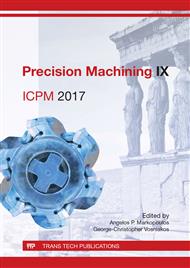p.58
p.69
p.77
p.85
p.93
p.101
p.108
p.115
p.121
In-Plane Longitudinal Cutting in Single-Crystal Silicon Wafer Surface Micromachining
Abstract:
The current concept of grinding or abrasive machining involves the formation and removal of segmented strips of material termed chips from the surface of the solid. A novel cutting mechanism is hereby presented in this research study that suggests that the generation of chips from the surface does not occur but only a shearing process that splits material creating added surface features and textures in the silicon surface. This arises from the unique set of factors of abrasive grit size, thrust force, polishing speed, and polishing time that lead to phase transformations in the surface layers of the silicon wafers. Statistical analysis of the factor effects yielded results that show the surface roughness values, Ra and Rz, increasing without any appreciable change in the thickness of the silicon wafers. This can be attributed to the proposed cutting mechanism indicating that only in-plane surface shearing occurred due to the change of the silicon crystal structure from exhibiting brittle behavior to that of ductile mode of deformation. Moreover, experimental quantities of the specific energy for surface machining of silicon was calculated with an overall mean of 50.5 GPa. This is about 33% less than the currently accepted value and can be considered further evidence that polymorphic transitions to a softer material occurred rendering the surface layers more susceptible to longitudinal cutting deformation and fracture. A model based on the inverted spherical cap or spherical bottom geometry for the individual abrasive particle is also proposed, verified by a finite element method analysis simulation, that can mathematically describe this particular micromachining process.
Info:
Periodical:
Pages:
93-100
Citation:
Online since:
August 2017
Authors:
Keywords:
Price:
Сopyright:
© 2017 Trans Tech Publications Ltd. All Rights Reserved
Share:
Citation:


